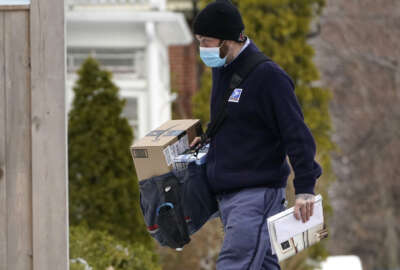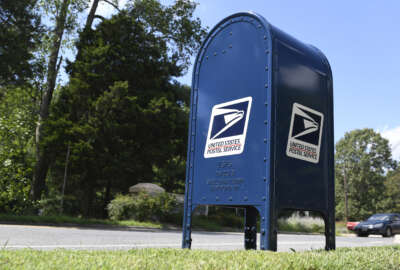USPS outlines $8B infrastructure investment in 2022 as sign of ‘bright future’
But union officials, members of the public and USPS officials are pushing back on the direction of USPS leadership.
The Postal Service, gearing up for its peak holiday season in the coming weeks, sees a significant reduction in its annual net losses, compared to recent years, as a sign that its 10-year reform plan is paying off.
But union officials, members of the public and USPS officials are pushing back on the direction of USPS leadership, following recent decisions to slow down delivery standards for nearly 40% of first-class mail, while also charging higher rates.
USPS ended fiscal 2021 with a $4.9 billion net loss, its 15th consecutive year of net losses. However, that net loss is nearly half the $9.2 billion loss it reported in fiscal 2020, and agency executives say USPS remains on track to break even as early as fiscal 2023.
Chief Financial Officer Joe Corbett told the USPS Board of Governors on Wednesday that the agency expects Congress to pass the Postal Service Reform Act next year, which would eliminate the agency’s obligation to pre-fund retiree health benefits well into the future.
If Congress passed the legislation next year, USPS expects to end fiscal 2022 with a $1.2 billion net loss, but Corbett said the agency remains on track to end its streak of net losses by 2023 or 2024.
“We’re in striking distance of breaking even,” Corbett said.
Without the legislation passing, USPS expects it will end this fiscal year with an $8.4 billion loss.
USPS also outlined more than $8 billion in capital investments in fiscal 2022, with about $4.7 billion going toward its next-generation delivery vehicle fleet. USPS would also spend $1.1 billion for facilities upgrades and $1.4 billion for processing equipment.
“We have starved this organization for a long period of time, to the detriment of, frankly, the organization and of the American public. We’re looking to really make some pretty large investments,” Corbett said.
‘Increased hostility’ over USPS service changes
Postmaster General Louis DeJoy said the rollout of these investments sets the organization on a “path for a bright future.”
Early progress with the 10-year plan, he added, demonstrates that the agency is getting through its long-term financial challenges and has a vision for its future.
“We have to believe, contrary to what our current and projected financial conditions proclaimed – that we were going to be here ten years from now,” DeJoy said.
As part of this plan, USPS implemented new service standards on Oct. 1 for first-class mail. DeJoy said the agency couldn’t uphold its previous three-day service standard without “continuing to incur significant and growing losses in attempting to do so.”
USPS Chief Technology Officer and Executive Vice President Scott Bombaugh said the agency delivered 88.52% of all first-class mail on time in the fourth quarter of fiscal 2021, when its new service standards went into effect. That’s a nearly 3% increase compared to the same period in FY 2020.
Customers, however, remain frustrated over the agency’s new service standards. Kimberly Karol, local president for the American Postal Workers Union (APWU) in Iowa, said she and her coworkers have faced “increased hostility and potential for violence against employees” as a result of service delays.
Karol, during a public comment period, said service standards in her state have increased to five days “and beyond,” costing customers late fees in bills and delaying delivery of prescription medications.
Customers, she said, take those frustrations out on front-line employees.
“I have been a victim of aggression in the workplace, and I believe that is a direct result of the implementation of the delays in the plan, and our inability to meet the expectations of our customers,” Karol said.
Chuck Zlatkin, legislative and political director for APWU in the New York metro area, said the union has seen an “increasing drop in morale among our employees,” as well as an increase in complaints from customers about delays.
While Zlatkin welcomed USPS bringing more employees into its career ranks, he said the agency is seeing a high rate of turnover for temporary employees brought on for peak holiday operations.
“What we’re hearing from the field is that people hired in this capacity are quitting after one or two days. They can’t take it,” Zlatkin said.
USPS has converted more than 33,000 non-career employees to career status this year, in an effort to reduce workforce turnover. DeJoy said USPS previously had a 40% turnover rate for its pre-career workforce.
Between investments in its workforce and infrastructure, DeJoy said USPS expects to avoid major delays this holiday season.
“We are ready, so send us your packages and your mail, and we will deliver them timely,” he said.
USPS re-elects chairman with limited tenure
The USPS Board of Governors voted to re-elect its chairman, Ron Bloom, to stay on as its leader at its quarterly meeting Wednesday, over the objections of two of President Joe Biden’s recently confirmed picks.
Regardless of the election’s outcome, Bloom’s tenure on the board runs out in less than a month, unless the White House and Congress intervene.
The Senate in 2019 confirmed Bloom to serve out the remainder of a term expiring in Dec. 2020, but all board members can stay on for an additional “holdover year.”
The last day of Bloom’s tenure, factoring in the holdover year, is Dec. 8. President Joe Biden has not yet indicated whether he intends to re-nominate Bloom. The alternative, however, sets the board up for the possibility of deciding on new leadership in the middle of its peak season.
Sen. Tammy Baldwin (D-Wis.) recently asked Biden to replace Bloom, rather than nominate him for a full term, citing Bloom’s support of Postmaster General Louis DeJoy and persistent mail delays.
Two of Biden’s picks on the board, former Deputy Postmaster General Ron Stroman and Anton Hajjar, former general counsel for APWU, requested to delay Wednesday’s election, but were overruled by the board.
The board also denied requests from Stroman and Hajjar to comment on the election. When put to a vote, Stroman and Hajjar voted against Bloom’s re-election.
The board also reelected Roman Martinez as the board’s vice-chairman.
Bloom’s reelection drew criticism during the meeting’s public comment period.
“Why would the Board of Governors elect someone that’s not supposed to be there, unless you’re trying to send a message to President Biden that you want to keep Bloom?” asked Jonathan Smith, local APWU president for the New York metro area.
As part of its infrastructure upgrades, USPS may soon receive $6 billion from Congress to purchase more electric vehicles as part of its next-generation fleet.
USPS, under the Build Back Better framework, would get more than $2.5 billion to purchase more electric delivery trucks as part of its next-generation fleet, as well as $3.5 billion for infrastructure, such as charging stations at its facilities.
While USPS must no longer defend its vehicle contract award to Oshkosh Defense, the vendor’s decision to manufacture USPS trucks in Spartanburg, South Carolina is running into criticism from United Auto Workers (UAW).
UAW Local 578 President Robert Lynk, an Oshkosh Defense employee, said the company’s decision to manufacture USPS vehicles using a non-union workforce outside its home base in Oshkosh, Wisconsin means the “company will be able to pit worker against worker and hold new work hostage to demands over wages and working conditions.”
“It looks to us like public money is being used to weaken the union. We want our postal workers to have new, safe, energy-efficient trucks. We think using an established, skilled, trained workforce is the best way to meet the demands for quality trucks to be delivered on time,” Lynk said.
Copyright © 2025 Federal News Network. All rights reserved. This website is not intended for users located within the European Economic Area.
Jory Heckman is a reporter at Federal News Network covering U.S. Postal Service, IRS, big data and technology issues.
Follow @jheckmanWFED






